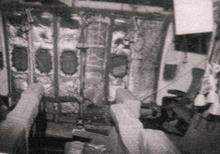Philippine Airlines Flight 434
After the bomb detonated, 58-year-old veteran pilot Captain Eduardo "Ed" Reyes was able to land the aircraft, saving it and the remaining passengers and crew.
[2] Authorities later discovered that Ramzi Yousef, a passenger on the aircraft's prior flight leg from Manila's Ninoy Aquino International Airport, had placed the explosive.
[4] The aircraft operating Flight 434 was a 15-year-old Boeing 747-283BM Combi owned by Guinness Peat Aviation (GPA), registered as EI-BWF, serial number 21575.
[7][8] It first flew on February 17, 1979, and was delivered to Scandinavian Airlines (SAS) on March 2, 1979, as SE-DFZ, operating the plane as "Knut Viking".
Yousef removed a modified Casio digital watch from his wrist to use as a timer, unpacked the remaining materials from his toiletry bag, and assembled his bomb.
He set the timer for four hours later, when he would be long disembarked and the plane would be far out over the ocean and en route to Tokyo during the next leg of its journey, put the entire bomb back into the bag, and returned to his assigned seat.
In order to prevent additional panic, Bayot called another flight attendant over to give the appearance that they were tending to Ikegami's needs with a blanket and oxygen mask, then reported the extent of the passenger injuries to the cockpit.
Additionally, due to the 38-minute delay in takeoff from Cebu the plane was not as far out to sea as anticipated, which contributed to the captain's available options for an emergency landing.
[6] They directed a USAF Learjet towards PAL 434 to visually check for damage of the outer fuselage and to verify that the landing gear was in place.
[6] U.S. prosecutors said the device was a "Mark II" PETN "microbomb" constructed using Casio digital watches as described in Phase I of the Bojinka plot, for which this was a test.
[6] He was extradited back to the United States to face trial wherein the New York Supreme Court gave him a life sentence with an additional 240 years.
The flight deck and cabin crew members[12] were commended by President Fidel Ramos for their "professional handling of a potentially disastrous situation" and went their separate ways following the incident.
Ed Reyes transferred to Cebu Pacific to work as an Administrative Check Pilot, flight instructor, and DC-9 captain until his retirement in 2002.
It subsequently changed hands several times, always to air cargo companies, and was finally placed in storage in 2007 at Châteauroux-Centre "Marcel Dassault" Airport.
